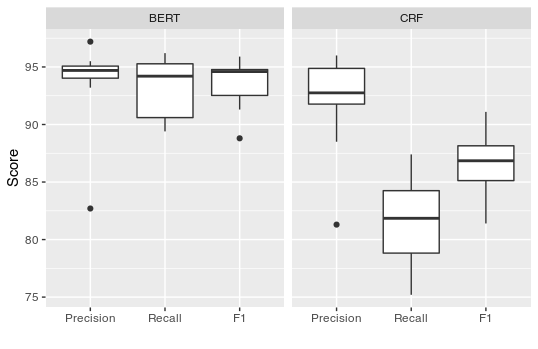language: de
thumbnail: https://huggingface.co/severinsimmler/literary-german-bert/raw/main/kfold.png
German BERT for literary texts
This German BERT is based on bert-base-german-dbmdz-cased, and has been adapted to the domain of literary texts by fine-tuning the language modeling task on the Corpus of German-Language Fiction. Afterwards the model was fine-tuned for named entity recognition on the DROC corpus, so you can use it to recognize protagonists in German novels.
Stats
Language modeling
The Corpus of German-Language Fiction consists of 3,194 documents with 203,516,988 tokens or 1,520,855 types. The publication year of the texts ranges from the 18th to the 20th century:
Results
After one epoch:
| Model | Perplexity |
|---|---|
| Vanilla BERT | 6.82 |
| Fine-tuned BERT | 4.98 |
Named entity recognition
The provided model was also fine-tuned for two epochs on 10,799 sentences for training, validated on 547 and tested on 1,845 with three labels: B-PER, I-PER and O.
Results
| Dataset | Precision | Recall | F1 |
|---|---|---|---|
| Dev | 96.4 | 87.3 | 91.6 |
| Test | 92.8 | 94.9 | 93.8 |
The model has also been evaluated using 10-fold cross validation and compared with a classic Conditional Random Field baseline described in Jannidis et al. (2015):
References
Markus Krug, Lukas Weimer, Isabella Reger, Luisa Macharowsky, Stephan Feldhaus, Frank Puppe, Fotis Jannidis, Description of a Corpus of Character References in German Novels, 2018.
Fotis Jannidis, Isabella Reger, Lukas Weimer, Markus Krug, Martin Toepfer, Frank Puppe, Automatische Erkennung von Figuren in deutschsprachigen Romanen, 2015.

